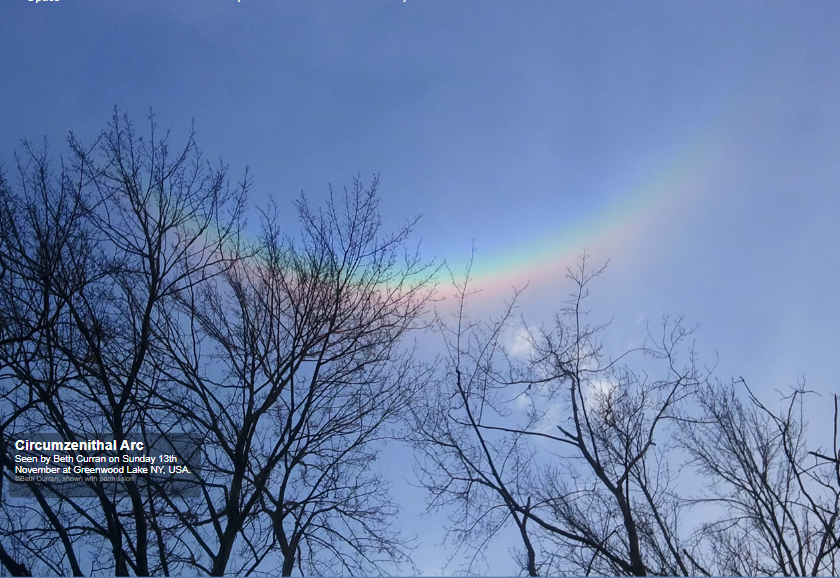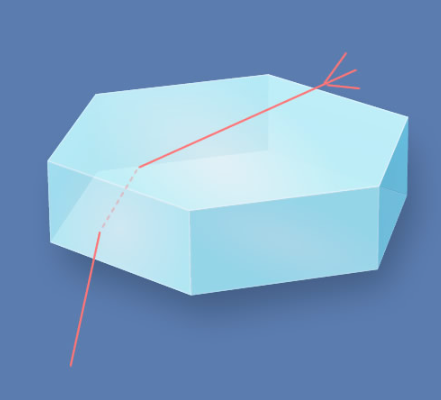OPOD - Greenwood Lake Circumzenithal Arc
The Enchanting Greenwood Lake Circumzenithal Arc
On a serene Sunday, November 13th, Beth Curran had the privilege of witnessing a captivating atmospheric phenomenon known as the circumzenithal arc (CZA) at Greenwood Lake, NY, USA. This celestial spectacle, often described as an "upside down rainbow," appeared as a radiant bow suspended improbably around the zenith. Its ethereal beauty leaves observers in awe, as if a rainbow had taken flight from its watery origins and embraced the sky with its enchanting presence.
When the sun is relatively low in the sky and sundogs are visible, one should direct their gaze towards the zenith to catch a glimpse of the CZA. This mesmerizing halo is not a complete circle but rather an arc that centers itself sunwards and showcases red hues on its outer edge. Its position near the zenith adds to its allure, as it seems to defy gravity by appearing upside down compared to a conventional rainbow.
The CZA owes its existence to hexagonal plate ice crystals, ranging in size from 0.05mm to a few millimeters. These crystals descend through cirrus clouds, aligning themselves aerodynamically with the surrounding air currents. As a result, the CZA-forming rays of light enter through a large top face of the ice crystals and exit through a nearly vertical side face. This unique geometry allows for the incident sunlight to refract through facets that are 90° to one another, causing the colors to separate widely and creating a pure non-overlapped spectrum.
Unlike a complete circle around the zenith, which is an exceptionally rare occurrence known as the Kern arc, the CZA presents itself as an arc rather than a full circle. Its rarity and distinctive shape contribute to its reputation as one of the most beautiful ice halos ever observed. Its vibrant colors and ethereal appearance make it a sight to behold, evoking emotions of wonder and enchantment.
As with many atmospheric optics phenomena, the CZA's appearance is highly dependent on specific atmospheric conditions. The presence of cirrus clouds, combined with the correct alignment of ice crystals, is crucial for the formation of this extraordinary halo. This dependence on specific conditions adds to the intrigue and elusiveness of the CZA, making each sighting a unique and cherished experience.
It is important to note that the CZA is not a rainbow, despite its resemblance. While rainbows are formed by the dispersion and reflection of sunlight by water droplets, the CZA's formation relies on the refraction of light through ice crystals. Understanding these distinctions allows for a deeper appreciation of the intricate and diverse phenomena that can occur within our atmosphere.
Beth Curran's fortunate encounter with the Greenwood Lake Circumzenithal Arc serves as a reminder of the hidden wonders that can grace our skies. These fleeting moments of atmospheric magic capture our imagination and inspire us to delve deeper into the intricacies of our natural world. As we continue to explore and unravel the mysteries of atmospheric optics, let us remain in awe of the remarkable phenomena that surround us, always ready to embrace the unexpected beauty that lies just beyond our line of sight.

Circumzenithal Arc
Seen by Beth Curran on Sunday 13th November at Greenwood Lake NY, USA.
©Beth Curran, shown with permission

The circumzenithal arc, CZA, is the most beautiful of all the ice halos. The first sighting is always a surprise, an ethereal rainbow fled from its watery origins and wrapped improbably about the zenith. It is often described as an "upside down rainbow" by first timers. Someone also charmingly likened it to "a grin in the sky".
Look straight up near to the zenith when the sun if fairly low and especially if sundogs are visible. The centre of the bow always sunwards and red is on the outside.
The CZA is never a complete circle around the zenith, that is the exceptionally rare Kern arc.
The halo, not a rainbow, is produced by hexagonal plate ice crystals ranging from 0.05mm across to a millimetre or so. The crystals drift downwards relative to air currents within cirrus cloud and become aerodynamically aligned. CZA forming rays enter a large top face and leave via a near vertical side face. The almost parallel incident sunlight generates a pure non-overlapped spectrum and the refraction through facets 90° to one another separates the colours widely.
Note: this article has been automatically converted from the old site and may not appear as intended. You can find the original article here.
Reference Atmospheric Optics
If you use any of the definitions, information, or data presented on Atmospheric Optics, please copy the link or reference below to properly credit us as the reference source. Thank you!
-
<a href="https://atoptics.co.uk/blog/opod-greenwood-lake-circumzenithal-arc/">OPOD - Greenwood Lake Circumzenithal Arc</a>
-
"OPOD - Greenwood Lake Circumzenithal Arc". Atmospheric Optics. Accessed on April 19, 2024. https://atoptics.co.uk/blog/opod-greenwood-lake-circumzenithal-arc/.
-
"OPOD - Greenwood Lake Circumzenithal Arc". Atmospheric Optics, https://atoptics.co.uk/blog/opod-greenwood-lake-circumzenithal-arc/. Accessed 19 April, 2024
-
OPOD - Greenwood Lake Circumzenithal Arc. Atmospheric Optics. Retrieved from https://atoptics.co.uk/blog/opod-greenwood-lake-circumzenithal-arc/.